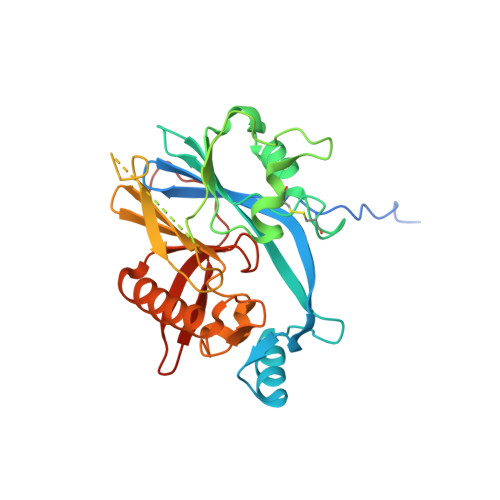Structural and Enzymatic Characterization of the Phosphotriesterase OPHC2 from Pseudomonas pseudoalcaligenes.
Gotthard, G., Hiblot, J., Gonzalez, D., Elias, M., Chabriere, E.(2013) PLoS One 8: e77995-e77995
- PubMed: 24223749
- DOI: https://doi.org/10.1371/journal.pone.0077995
- Primary Citation of Related Structures:
4LE6 - PubMed Abstract:
Organophosphates (OPs) are neurotoxic compounds for which current methods of elimination are unsatisfactory; thus bio-remediation is considered as a promising alternative. Here we provide the structural and enzymatic characterization of the recently identified enzyme isolated from Pseudomonas pseudoalcaligenes dubbed OPHC2. OPHC2 belongs to the metallo-¦Â-lactamase superfamily and exhibits an unusual thermal resistance and some OP degrading abilities. The X-ray structure of OPHC2 has been solved at 2.1 ? resolution. The enzyme is roughly globular exhibiting a ¦Á¦Â/¦Â¦Á topology typical of the metallo-¦Â-lactamase superfamily. Several structural determinants, such as an extended dimerization surface and an intramolecular disulfide bridge, common features in thermostable enzymes, are consistent with its high Tm (97.8ˇăC). Additionally, we provide the enzymatic characterization of OPHC2 against a wide range of OPs, esters and lactones. OPHC2 possesses a broad substrate activity spectrum, since it hydrolyzes various phosphotriesters, esters, and a lactone. Because of its organophosphorus hydrolase activity, and given its intrinsic thermostability, OPHC2 is an interesting candidate for the development of an OPs bio-decontaminant. Its X-ray structure shed light on its active site, and provides key information for the understanding of the substrate binding mode and catalysis.
Organizational Affiliation:
URMITE UMR CNRS-IRD 6236, IFR48, Facult¨¦ de M¨¦decine et de Pharmacie, Universit¨¦ de la M¨¦diterran¨¦e, Marseille, France.




















